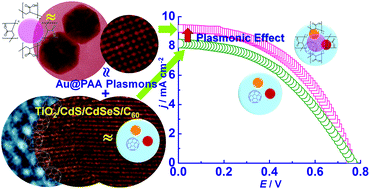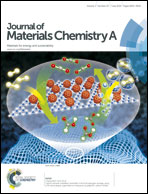Au@poly(acrylic acid) plasmons and C60 improve the light harvesting capability of a TiO2/CdS/CdSeS photoanode†
Abstract
A quantum dot solar cell (QDSC) was developed using a photoanode with CdS and CdSeS QDs as co-sensitizers, fullerene (C60) clusters as electron conduits and Au nanoparticles capped by poly(acrylic acid) or Au@PAA as plasmons, which were all tethered to TiO2 as the semiconducting scaffold. The formation of CdSeS QDs and hexagon-shaped Au@PAA, each with a face-centered cubic lattice, was confirmed by high-resolution transmission electron microscopy. Evidence for rapid electron injection from CdS or CdSeS to C60 and Au@PAA, as well as for inter-dot electron transfer from CdS to CdSeS, were obtained from fluorescence quenching and emission decay lifetime analyses. The fastest electron deactivation pathway was achieved in the TiO2/CdS/CdSeS/C60/Au@PAA electrode, which demonstrated the ability of C60 and Au@PAA to serve as efficient electron sinks due to their high electronic conductivities and their favorably poised Fermi levels. Au@PAA particles induced absorbance increments of CdS and CdSeS QDs, thus indicating that plasmonic improvements could be exploited in the photoanode using the same. High electron transfer rates and plasmonic effects translated into a high overall power conversion efficiency of 3.61% for a QDSC constructed with this composite as the photoanode, aqueous S2− as the electrolyte and carbon-nanotube-based counter electrode. The efficiencies of cells without Au@PAA and C60 were lower by ∼19% and 23%, respectively, confirming the synergy between C60 and Au@PAA in producing larger photocurrents. Aligned conduction bands in the TiO2/CdS/CdSeS/C60/Au@PAA electrode that permitted electron transfer by cascade, broader spectral utilization by using CdS and CdSeS and near field plasmonic enhancement by Au@PAA due to its proximity with the QDs, cumulatively manifested in an incident photon to current conversion efficiency of 48%, which is 25% greater than that of the cell without Au@PAA. Our study shows that significant improvements in QDSC performances can be realized by simply developing more efficient designs for photoanode configurations.


 Please wait while we load your content...
Please wait while we load your content...